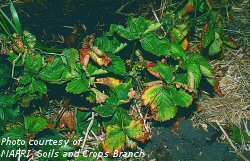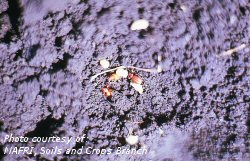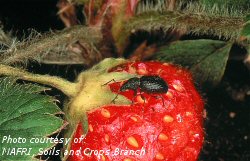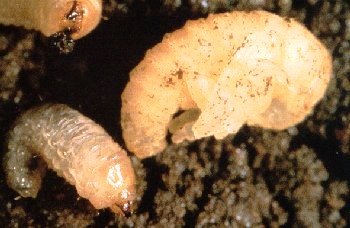Root Weevils

Root weevil damage to strawberry

Root weevil larvae, pupae and adults on soil surface

Strawberry root weevil adult

Host Plants And Distribution
Root weevils are found in all growing areas in the northern U.S. and Canada, feeding primarily on strawberry and raspberry, but will also attack loganberry, blueberry, grapes, azalea, hemlock, rhododendron, primrose and many other ornamentals.
Biology
Adult strawberry root weevils are about 5 to 8 mm long. They are usually black, but some may be light-to dark-brown. They have rows of round punctures on the wing covers. All the adults are females. They cannot fly. Larval root weevils are legless grubs with pinkish-white "C-shaped" bodies and brown heads. They are about 6 mm long.
Root weevils reproduce asexually and all root weevils are therefore female. These beetles are unable to fly and are active at night. Most root weevils overwinter as larvae near the roots of their host plants. In spring they pupate and adults begin to emerge in early July. Adult weevils are 5-9 mm long and vary in colour from black to light brown to gray in colour, depending upon the species. In late July, the females deposit the eggs near the crown of the host plant. The eggs hatch and the larvae burrow into the soil to feed on the roots for the remainder of the season. Larvae are legless grubs with whitish bodies and brown heads and reach a length of 6 mm. There is one generation per year.
Symptoms Of Damage
The larvae devour the roots and the adults feed on the edges of leaves. Injury from the adult weevils feeding on leaves and fruit is relatively unimportant except as an indicator of weevil presence. Most injury results from the larvae feeding on the roots. Plants are stunted, the foliage turns red, and fruit is small and seedy. Injured plants may wilt and die during dry periods in summer. When numerous, these insects can destroy a strawberry planting in one season.
Monitoring
Because root weevils cannot fly, it may take weevil populations 2-3 years to spread across a large strawberry field. If weevils are found throughout the field, they have been there for some time already. In new fields, carefully examine plants along fence rows and sodded edges. Inspect the field edges every week or two during July and August. Look for notched leaf margins. If seen, use a flashlight to examine the foliage at night for the adult beetles. Use a sweep net to collect some adult weevils for identification. In the fall, you can check for larvae by collecting stressed plants and slitting open the roots to check to tunneling and for larvae.
Economic Thresholds
A field free of root weevils obviously needs no treatment. Avoid spraying to save money and to reduce the possibility of secondary problems that may occur if the beneficial predators and parasites of other pests are killed. Although severe infestations of root weevils are rare in Manitoba, some workers recommend treatment of even lightly-infested fields, to prevent egg-laying and the build-up of weevils.
Severe infestations in Manitoba are relatively uncommon; therefore, control measures are usually not necessary. No economic thresholds have been established for root weevils.
Scouting TechniquesScouting should initially be carried out at the margins of fields. As the weevils cannot fly, early infestations will occur at field edges due to adult weevils walking into the field. Infestations spread slowly. Fields should be monitored in July or August for notching in the edges of leaves, which is caused by adult feeding. If notching is observed, return at night with a flashlight to examine the foliage for adult beetles.
Comments
To minimize root weevil damage in strawberry fields, fall ploughing will help protect the spring planting. Crop rotation also helps. Damage can be reduced when new plantings are placed in non-infested soil, as far as possible from old plantings. Do not establish plantings next to woodlots or allow hedgerows or overgrown fences nearby. These areas may become overwintering places for adult strawberry weevils. Note that this has to be balanced against the use of shelterbelts for snow retention and to minimize wind damage. Barriers of cultivated soil around the perimeters of fields will help protect crops from the attacks of crawling weevils. Use strawberry varieties that can regenerate their roots.
